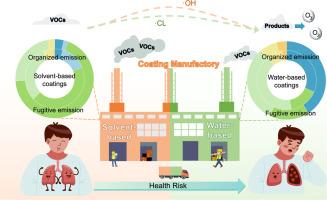Characteristics of VOCs in coating materials manufacturing and contributions to environmental implication based on on-site sampling in Shandong Province
IF 6.3
2区 环境科学与生态学
Q1 ENVIRONMENTAL SCIENCES
引用次数: 0
Abstract
Volatile organic compounds (VOCs) are a significant class of air contaminants, and their anthropogenic emissions in the environment are crucial for understanding and controlling VOC pollution and associated ozone formation. Numerous studies have assessed VOC emissions from critical industrial sources in China, but understanding VOC emissions within the coating materials manufacturing industry remains limited. This study elucidates the characteristics of VOC emissions from the coating materials manufacturing industry through a comprehensive sector-based field sampling, constructs the emission source profiles, quantifies provincial-level VOC emissions, and evaluates the potential health risks to workers. According to experimental results, the main emissions from water-based coatings are oxygenated volatile organic compounds, which significantly contribute to ozone (O3) formation. The highest emissions from solvent-based coatings are aromatics. Health risk analysis revealed potential health impacts on workers in the workshop, indicating that solvent-based workshops posing a higher carcinogenic risk than water-based coating workshops. Strict control measures for fugitive emissions should be implemented to mitigate human health risks. Our results also demonstrate that the VOC emissions from coating materials manufacturing are mainly influenced by regional imbalances in coating production in China. Additionally, we explore the •OH and Cl• radical chemistry with ethyl acetate, revealing that Cl• is more likely to undergo H-abstraction reactions (HAA) than •OH. This study provides a source profile of the coating materials manufacturing industry and offers guidance on minimizing environmental impacts and promoting healthier working environments in the industry.

山东省涂料生产过程中挥发性有机化合物的特征及其对环境的影响
挥发性有机化合物(VOCs)是一类重要的空气污染物,其在环境中的人为排放对于了解和控制VOC污染和相关臭氧形成至关重要。许多研究已经评估了中国主要工业来源的VOC排放,但对涂料制造行业VOC排放的了解仍然有限。本研究通过全面的基于行业的实地抽样,阐明了涂料制造业VOC排放特征,构建了排放源概况,量化了省级VOC排放量,并评估了工人的潜在健康风险。实验结果表明,水性涂料的主要排放物是含氧挥发性有机物,这对臭氧(O3)的形成有很大的促进作用。溶剂型涂料排放最多的是芳烃。健康风险分析揭示了对车间工人的潜在健康影响,表明溶剂型车间比水性涂料车间具有更高的致癌风险。应实施严格的逸散排放控制措施,以减轻人类健康风险。研究结果还表明,涂料生产过程中挥发性有机化合物的排放主要受到中国涂料生产区域不平衡的影响。此外,我们用乙酸乙酯研究了•OH和Cl•自由基的化学反应,发现Cl•比•OH更容易发生h -提取反应(HAA)。本研究提供了涂料制造行业的来源概况,并为减少环境影响和促进行业更健康的工作环境提供了指导。
本文章由计算机程序翻译,如有差异,请以英文原文为准。
求助全文
约1分钟内获得全文
求助全文
来源期刊

Journal of Environmental Sciences-china
环境科学-环境科学
CiteScore
13.70
自引率
0.00%
发文量
6354
审稿时长
2.6 months
期刊介绍:
The Journal of Environmental Sciences is an international journal started in 1989. The journal is devoted to publish original, peer-reviewed research papers on main aspects of environmental sciences, such as environmental chemistry, environmental biology, ecology, geosciences and environmental physics. Appropriate subjects include basic and applied research on atmospheric, terrestrial and aquatic environments, pollution control and abatement technology, conservation of natural resources, environmental health and toxicology. Announcements of international environmental science meetings and other recent information are also included.
 求助内容:
求助内容: 应助结果提醒方式:
应助结果提醒方式:


